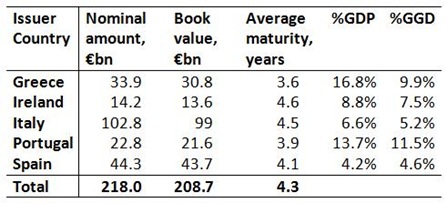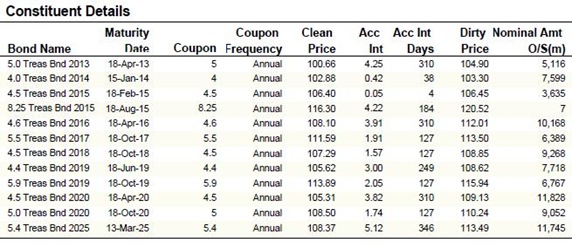In the discussion around the Promissory Note/Long-Term Government Bond swap it quickly became clear that the benefits of the new arrangement are dependent on how long the Central Bank of Ireland holds the €28 billion of bonds it has received.
On Thursday, the ECB also confirmed the substantial bond holdings that it and the various National Central Banks (NCBs) in the Eurosystem of Central Banks (ESCB) accumulated as part of the now-defunct Securities Market Programme. Here are the figures published by the ECB along with the nominal amount of a percentage of 2012 Gross Domestic Product (GDP) and 2012 General Government Gross Debt (GGD) using IMF estimates.

Here is the list of Irish government bonds from which the €14.2 billion held by the ESCB will be drawn. Click to enlarge.

As previously pointed out an agreement in the Eurogroup made in February 2012 will see the income profits the NCBs make on their Greek bonds recycled back to Greece. In November 2012 this was confirmed as:
A commitment by Member States to pass on to Greece's segregated account, an amount equivalent to the income on the SMP portfolio accruing to their national central bank as from budget year 2013.
As can be seen in the second table the average annual interest coupon on Irish government bonds is close to five percent. The NCBs will be paying for the facility to hold the bonds at the ECB’s main refinancing rate, which is currently 0.75%. Even allowing for other costs, and a possible transfer to the reserves of the NCBs, it is clear that a significant profit will be made by the NCBs on the interest from these bonds.
When the Greek arrangement was re-affirmed in November 2012 it was estimated that it would reduce Greek government debt by 4.6 percentage points of GDP by 2020.
Relative to GDP the Irish holdings are about half as large as those of Greece though the average maturity is one year longer. It is possible that if a similar arrangement was put in place for Ireland the amounts involved over the next few years could be from 1.5% to 2% of GDP – a very significant sum.
The €14 billion of bonds held by the ESCB are likely to generate close to €700 million of interest payments this year, though it is likely that a significant portion of bond due to mature on the 13th of April will be in the holding. A profit on the interest for the NCBs of around €500 million (0.3% of Irish GDP) is possible this year, and this will decline as the bonds mature.
The balance sheet of the Central Bank of Ireland (.xls) does not indicate that it holds a significant portion of these bonds. From the time the SMP was instituted in May 2010 “Securities of other euro area residents in euro” held by the CBoI increased from €16.5 billion to €20.7 billion by the time the SMP was shelved in March 2012. Both transactions and revaluation effects will have contributed to the increase. The asset item “General Government debt in euro” has never had a non-zero figure reported in the balance sheet.
I appeared before the Joint Oireachtas Committee on EU Affairs last Thursday and this issue was raised during the meeting (full transcript). My comments in response to the query are below the fold. [Note: The ECB published the actual figures on the amount of bonds at the same time as the meeting began but it is clear that the estimated figures in the public domain were “in the ball park”.]
Mr. Seamus Coffey: I will take the issue of the ECB bondholdings first and, maybe, then move on to some subsequent issues.
The Chair has introduced a useful topic. The figures in this regard are unconfirmed, although a set of figures was presented to the Governor of the Central Bank, Professor Patrick Honohan, at the Joint Committee on Finance, Public Expenditure and Reform recently and he did not deny them. I think we can take it that they are in the ball park.
The ECB had what it calls the securities market programme where it bought Government bonds. It started in 2010. The programme ended in March of last year. The programme is now over but its legacy is substantial government bondholdings by the various national central banks in the eurozone which carried out the policy on behalf of the ECB. Most of the activity took place after the July 2011 European Council meeting that finally admitted that a Greek default was necessary but, perhaps, did not go far enough. Because private sector involvement was finally admitted in the case of Greece, to try to cushion some of the consequences for the other countries that were under pressure the ECB stepped in and really stepped up its bond buying over the coming months. Irish bonds formed part of that. It looks like they had somewhere in the region of €18 billion to €22 billion of Irish Government bonds bought in a fairly short period. Most of them focused on what we might call "the short end." These were bonds coming to maturity over a fairly short period - two, three or four years. Since then, there have been two sovereign bond maturities in Ireland. There was a November 2011 bond that matured and also a March 2012 one. Many of the bonds that were bought might have matured and been redeemed, but the figures would still have been quite large.
At a eurogroup meeting in February last it was agreed that the national central banks would recycle some of the profits they were making on these bonds back to Greece. As attempts were made to bring down their debt-to-GDP ratio, one approach taken was that there was this money flowing out of Greece and maybe they could get it to flow back in. In the main, as we now will be aware, when central banks make profits they return them back to their sovereign. In our case, we expect the Central Bank to make substantial profits on Government bonds, but these merely happen to be our own Government's bonds and we hope the Central Bank can hold on to them for as long as possible because the interest we pay on them to the Central Bank is then recycled back to the Exchequer. If there is a profit on any interest that is paid on the Irish bonds now held by the national central banks across Europe, it can be returned to the exchequer in those countries and we hope, perhaps, they will return it to us.
The issue is made up of two elements. The Chair spoke about the profit that the central banks will make. The profit is made up of the annual interest - coupon - they get every year and the capital appreciation. There is not too much we can do about the capital appreciation. The central banks will require a certain return for taking on the risk of buying Irish Government bonds, and this was particularly the case in the autumn of 2011 when sovereign bond markets were quite heated.
We can focus particularly on the annual interest, which might not grab as large a headline as focusing on the capital but which sums can be quite large. Here, the central banks are making a cheap and easy profit. The central banks get access to funds at a very cheap rate. They can get the funds at the ECB rate and they have bought these Irish Government bonds. They might have made a profit by buying them at 70 bps or 75 bps, but they are making that profit off somebody else. They are making that profit off the person who sold the bonds. That really is of little concern to us. We borrowed €100 whenever the bonds were issued, say, in 2006 or 2007, and we will pay back €100. The central banks themselves are not making a profit off us on that basis. What they are making a profit on will be the interest that we will now pay on an annual basis on those bonds. Perhaps we should target and try to get back the interest, which is the substance of the Greek deal where the interest that is paid on bonds is then recycled back to the Greek central bank which can return it to the Greek exchequer.
The sums have potential to be reasonably large. Given some of the redemptions, there could be - I merely pick a figure - €12 billion of these bonds still being held by the national central banks across Europe. At a rough 5% annual coupon, one is talking about €600 million of interest per year. We have a massive interest bill, approaching €8 billion. Some €600 million of that could be going to the national central banks of Europe. The money they are borrowing from the ECB for this facility could be costing them €100 million and, potentially, there is a €500 million per annum profit or income for the national central banks across Europe on their holdings of Irish Government bonds. The central banks will benefit because they got to buy them cheap but as of yet, there has been no benefit for Ireland. We were not in bond markets in July and August 2011 when these bonds were being bought. This was, apparently, done for our benefit. It was to try to stabilise European bond markets but as of yet, we have got no real benefit because it is only subsequently that we got back into markets. This potential €500 million is there and could be recycled back to the Central Bank of Ireland which would give it back to the Exchequer. It would be a welcome boost to the public finances.





No comments:
Post a Comment